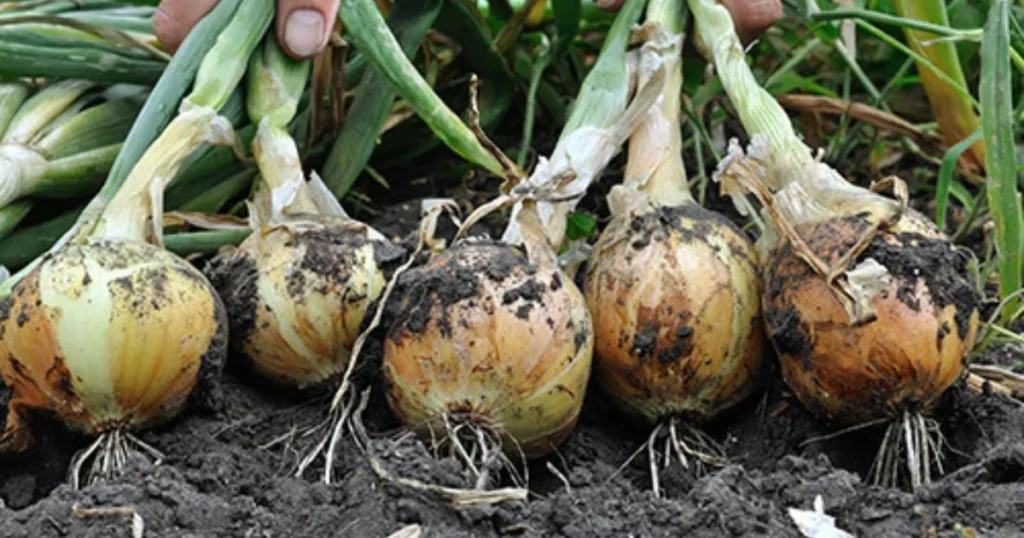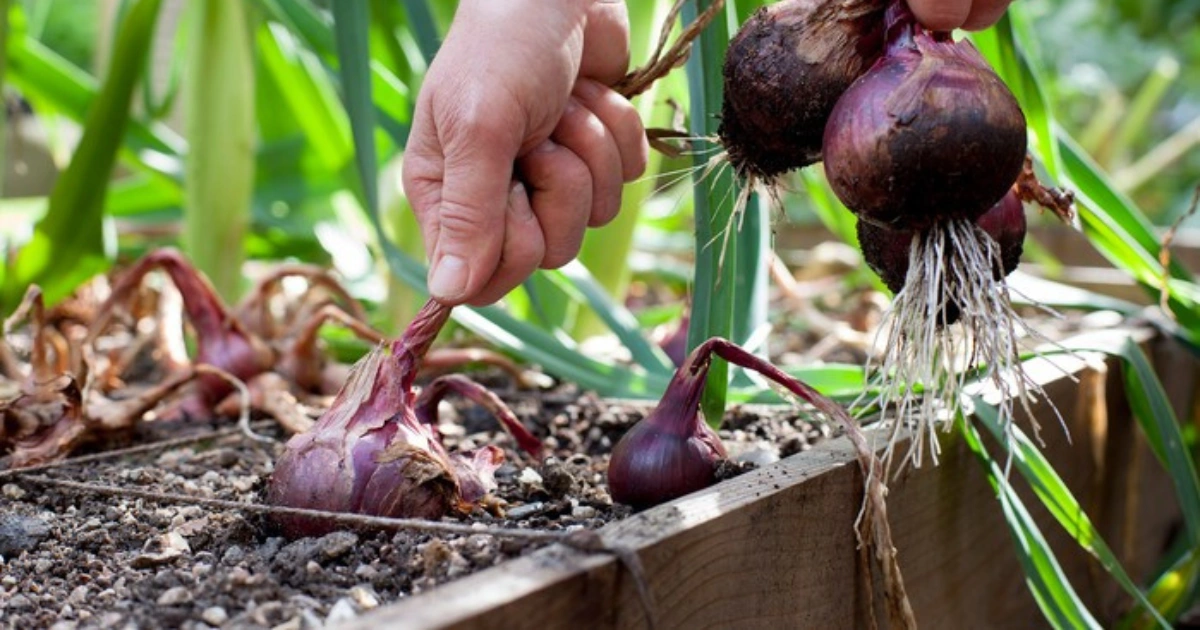Growing onions at home is easier than most people think, especially when using a crate gardening method. Even with limited space like a balcony or patio, you can cultivate fresh, flavorful onions using wooden crates. This practical and compact technique makes it possible to enjoy homegrown onions without needing a full garden bed.
In this guide, you’ll learn step-by-step how to grow onions in crates—from selecting the right onion type to harvesting bulbs for your kitchen.

Why Crate Gardening Works for Onions
Wooden crates offer an ideal growing environment for onions due to their shallow root systems. These containers ensure:
- Excellent drainage
- Good air circulation
- Easier control of soil quality
- Space-saving vertical stacking for small areas
Crates are also portable and can be positioned anywhere you get 6+ hours of sun, making them perfect for small-space or urban gardeners.
Materials You’ll Need
To start your onion crate garden, gather the following supplies:
- A wooden crate (minimum 8–12 inches deep)
- Landscape fabric or old burlap (for lining)
- Potting mix combined with compost
- Onion sets (small bulbs) or seedlings
- Organic fertilizer
- Mulch (optional)
- A watering can or hose with gentle pressure
Drill drainage holes if your crate doesn’t have them. Line the crate with landscape fabric to hold the soil in while allowing water to escape.
Best Onion Varieties for Crate Growing
Choosing the right type of onion is essential, especially when growing in containers. Here are your primary options:
Short-Day Onions
- Ideal for warmer climates with mild winters
- Bulbs form when daylight reaches 10–12 hours
Long-Day Onions
- Suitable for northern regions with long summer days
- Bulbs develop at 14–16 hours of daylight
Day-Neutral Onions
- Great for most growing zones
- Bulb development is not affected by day length
Top choices for crate cultivation:
- ‘White Lisbon’
- ‘Evergreen Bunching’
- ‘Red Baron’
Bunching onions (scallions) are especially productive and can be harvested multiple times.
Planting Instructions
Step 1: Prepare the Soil
Fill the crate with a blend of quality potting soil and compost. Onions prefer loose, well-aerated soil rich in organic material.
Step 2: Spacing and Depth
- Plant onion sets or seedlings 3–4 inches apart
- Keep rows 6 inches apart
- Bury just deep enough so the tip is level with the soil
Step 3: Location
Place your crate in a sunny area that receives at least 6 hours of sunlight daily. Onions need light to grow properly and form healthy bulbs.
Maintenance Tips for Healthy Onion Growth
Watering
- Keep the soil consistently moist, especially early in the growing season
- Avoid overwatering, which can cause root rot
Fertilizing
- Use a nitrogen-rich organic fertilizer every 2–3 weeks
- Reduce nitrogen application once bulbs begin to form to avoid delaying maturation
Mulching
- Apply a layer of straw or grass clippings to retain moisture and suppress weeds
- Helps maintain even soil temperatures and keeps bulbs clean
Monitor soil moisture frequently—crate soil can dry out faster than traditional beds.
Common Pests and How to Manage Them
While onions are relatively pest-resistant, keep an eye out for:
- Onion maggots: Prevent with crop rotation and avoid overwatering
- Thrips: Use neem oil or insecticidal soap to manage infestations
- Fungal diseases: Improve airflow and avoid overhead watering
Inspect plants weekly for signs of distress, such as stunted growth or yellowing leaves.
Harvesting Your Crate-Grown Onions
Onions are typically ready to harvest when:
- Their tops turn yellow and flop over
- Bulbs protrude slightly above the soil and have a dry, papery skin
To harvest:
- Gently pull or fork them out of the soil
- Let them cure in a shaded, ventilated spot for 7–10 days
- Trim roots and tops, then store in a cool, dry location
For green onions or scallions, harvest when the leaves reach 6–8 inches tall. They’ll regrow several times if the base remains intact.
Crop Rotation and Reuse of Crates
After harvesting:
- Refresh the soil with compost or organic matter
- Avoid planting onions in the same crate each season
- Rotate with crops like leafy greens or herbs to prevent pest buildup
Final Thoughts
Growing onions in wooden crates is an efficient and satisfying gardening method for small spaces. With proper sunlight, soil care, and timely maintenance, you can enjoy a steady supply of fresh onions all season long. Whether you’re a beginner or seasoned gardener, this technique offers flexibility, productivity, and the unbeatable taste of homegrown produce.
Frequently Asked Questions (FAQs)
How long does it take to grow onions in crates?
Most onions take 90–120 days to reach full maturity, depending on the variety and growing conditions.
Can I grow onions from kitchen scraps?
Yes, you can regrow green onions from cuttings by placing the roots in water, then transplanting them into your crate once they sprout.
Do onions need full sun?
Yes, onions require at least 6–8 hours of direct sunlight daily for proper bulb formation.
What should I do if my onions aren’t forming bulbs?
Check if the soil has too much nitrogen or if the onions aren’t getting enough light. Both factors can delay or prevent bulbing.
Can I reuse the soil from my onion crates?
Yes, but amend it with compost and avoid replanting the same crop immediately to prevent disease buildup.
Internal Link Suggestions (from secretsofthegreengarden.com)
- Crate Planters for Hot Chili Harvests in Small Spaces
- DIY Crate Gardening for Space-Saving Cabbage Crops
- Balcony Chilies: Grow Fire in a Wooden Crate
External Link Suggestions
- University of Minnesota Extension: Growing Onions
- Royal Horticultural Society: Onions Growing Guide
- The Old Farmer’s Almanac: Onion Planting Tips
Main keyword: grow onions in wooden crates
LSI/NLP keywords used: crate gardening, onion sets, potting mix, green onions, compost, shallow root system, container gardening, balcony garden, urban gardening
Internal link suggestions:
- Crate Planters for Hot Chili Harvests in Small Spaces
- DIY Crate Gardening for Space-Saving Cabbage Crops
- Balcony Chilies: Grow Fire in a Wooden Crate
External link suggestions: - University of Minnesota Extension: Growing Onions
- RHS Growing Guide: Onions
- Old Farmer’s Almanac: Onion Planting Tips


g4vojf
**mindvault**
mindvault is a premium cognitive support formula created for adults 45+. It’s thoughtfully designed to help maintain clear thinking
https://t.me/s/officials_pokerdom/3751
برای دوستانی که به دنبال یک راهکار مطمئن برای وریفای حساب در بروکرهای فارکس هستند، پیشنهاد میکنم خدمات شوپی را بررسی کنند. این مجموعه به صورت تخصصی، وریفای قانونی حساب های فارکس را با مدارکی ارائه میدهد که کاملاً معتبر بوده و به نام خودتان صادر میشود. این روش دائمی است و ریسک بلاک شدن حساب شما را به صفر میرساند. کیفیت و پشتیبانیشان واقعاً عالی است.
https://t.me/s/Irwin_officials
بعد از ثبت سفارش در سایت گرافیسو، فایل دیجیتال پکیج مدارک رو همون روز گرفتم و نسخه فیزیکی هم خیلی شکیل بستهبندی شده بود. پشتیبانی فوقالعاده پاسخگو بود. من از پکیج مدارک بینالمللیش استفاده کردم و واقعاً فراتر از انتظارم بود. طراحی کاملاً حرفهای و معتبر.
Nếu bạn đang tìm kiếm một sân chơi giải trí trực tuyến ổn định, hiện đại và đa dạng trò chơi, 188v me chính là lựa chọn đáng để trải nghiệm. Với hệ thống trò chơi phong phú như: Bắn Cá Đổi Thưởng, Mini Game Đá Gà, Xổ Số Ba Miền, Thể Thao Điện Tử,… Tại đây mang đến không gian giải trí sống động, phù hợp với nhiều đối tượng người dùng. TONY12-15